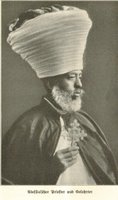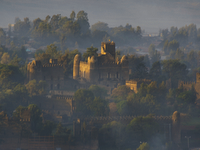 We are listing here the magical history of the rulers of Ethiopia from Ethiopian sources. In 1914, a document listing the line of sovereigns of Ethiopia was provide to the traveller Charles Rey by Ras Teferi, Regent of Ethiopia. This extensive and continues line of Kings and Queens has yet to tell wonderful stories of Kingdoms past, a challenging task for Ethiopianists. We will attempt to scrape off the mist of history and time to reveal the grandeur of Ethiopia, also known as Abyssinia. This will be a slow process, sort of like painting the Mona Lisa with the secret smile. Modifications will be slow and an on-going event or as the Ethiopian saying goes "patience turns milk into butter"
We are listing here the magical history of the rulers of Ethiopia from Ethiopian sources. In 1914, a document listing the line of sovereigns of Ethiopia was provide to the traveller Charles Rey by Ras Teferi, Regent of Ethiopia. This extensive and continues line of Kings and Queens has yet to tell wonderful stories of Kingdoms past, a challenging task for Ethiopianists. We will attempt to scrape off the mist of history and time to reveal the grandeur of Ethiopia, also known as Abyssinia. This will be a slow process, sort of like painting the Mona Lisa with the secret smile. Modifications will be slow and an on-going event or as the Ethiopian saying goes "patience turns milk into butter"1. Ori or Aram 4470 2. Gariak I 4404 3. Gannkam 4321 4. Queen Borsa 4254 5. Gariak II 4194 6. Djan I 4114 7. Djan II 4054 8. Senefrou 4034 9. Zeenabzamin 3976 10. Sahlan 3916 11. Elaryan 3836 12. Nimroud 3776 13. Queen Eylouka 3731 14. Saloug 3701 15. Kharid 3629 16. Hogeb 3529 17. Makaws 3459 18. Assa 3429 19. Affar 3379 20. Milanos 3317 21. Soliman Tehagui 3244 . The line continues with Kam.
1. Ahywa (Sofya, mother of Abreha Atsbeha). 2. Abreha Atsbeha (partly with his mother) 332 3. Atsbeha (alone) 344 4. Asfeh Dalz 351 5. Sahle 365 6. Arfed Gebra Maskal 369 7. Adhana I (Queen) 374 8. Riti 375 9. Asfeh II 376 10. Atsbeha II 381 11. Amey 396 12. Abreha II 7 months 13. Ilassahl 2 months 14. Elagabaz I 398 15. Suhal 402 16. Abreha III 412 17. Adhana II (Queen) 418 18. Yoab 428 19. Tsaham I 430 20. Amey II 431 21. Sahle Ahzob 433 22. Tsebah Mahana Kristos 436 23. Tsaham II 438 24. Elagabaz II 444 25. Agabi 445 26. Lewi 447 27. Ameda III 450 28. Armah Dawit 464 29. Amsi 469 30. Salayba 478 31. Alameda 486 32. Pazena Ezana 493 . Kaleb continues the line as a Dynasty until Emperor Gedajan.
Kaleb Dynasty:
1. Kaleb 523 2. Za Israel 1 month 3. Gabra Maskal 537 4. Kostantinos 565 5. Wasan Sagad 580 6. Fere Sanay 603 7. Advenz 623 8. Akala Wedem 631 9. Germa Asafar 646 10. Zergaz 656 11. Dagena Mikael 682 12. Bahr Ekla 701 13. Gum 725 14. Asguagum 730 15. Latem 746 16. Talatam 767 17. Gadagosh 780 18. Aizar Eskakatir 1/2 day 19. Dedem 78520. Wededem 795 21. Wudme Asfare 825 22. Armah 830 23. Degennajam 849 24. Gedajan 850 25. Gudit (Yodit, a Jewish Queen) 890 26. Anbase Wedem 910 27. Del Naad 920 . Events ends Solomonic dynasty and begins the Zagwe (line of Moses) Dynasty
V. ZAGWE Dynasty
1. Mara Takla Haymanot (Zagwe) 933 2. Tatawdem 973 3. Jan Seyum 1013 4. Germa Seyum 1053 5. Yermrhana Kristos 1093 6. Kedus Arbe (samt) 1133 7. Lalibala 1173 8. Nacuto Laab 1213 9. Yatbarak 1230 10. Mayrari 1245 11. Harbay 1253
(Israelite rulers during Zagwe Dynasty:1. Mahbara Wedem 2. Agbea Tsion 3. Tsinfa Arad 4. Nagash Zare 5. Asfeh 6. Yacob 7. Bahr Asagad 8. Edem Asagad).
VI. YEKUNO AMLAK AND HIS SOLOMONIC POSTERITY
1. Yekuno Amlak 1268 2. Yasbeo Tseyon 1277 3. Tsenfa Arad 1278 4. Hesba Asagad 1279 5. Kedme Asagad 1280 6. Jan Asagad 1281 7. Sabea Asagad 1282 8. Wedma Ared 1297 9. Amda Tseyon 1327 10. Saifa Ared 1355 11. Wedma Asfare 1365 12. Dawit 1395 13. Tewodoros 1399 14. Yeshak 1414 15. Andreyas 6 months 16. Hesba Nafi 1418 17. Bedl Nafi (6 mo with Andreyas) 1419 18. Amde Tseyon 1426 19. Zara Yacob 1460 20. Boeda Maryam 1470 21. Iskender 1486 22. Amda Tseyon 1487 23. Naod 1500
24. Lebna Dengel 1532 25. Galawdewos 1551 26. Minas 1555. The Emperors and Empresses moved around the realm until the establishment of Gonder as a Capital City. The line continues as House of Gondar.
1. Sartsa Dengel 1589 2. Yakob 1598 3. Za Dengel I 1599 4. Susneyos 1627 5. Fasil 1662 6. Degu-Johannis 1677 7. Adyam Sagad Iyasu 1702 8. Takla Haymanot 1704 9. Tewoflus 1707 10. Yostos 1711 11. Dawit 1716 12. Bakaffa 1725 13. Birhan Sagad Iyasu 1749 14.Iyoas 1764 15. Johannis 5 months + 5 days 16. Takla Haymanot 1772 17. Solomon 1774 18. Takla Giyorgis 1779 . The accession line continues by Princes who claimed the throne as Emperors. These Princes began the Zemene Mesafint Era.
1. T. Yasus 1784-88 2. Takla Haymanot 1788-89 3. Iskias 1789-95 4. Baeda Maryam 1795- 97 5. Junus 17976. Adimo 1797-99 7. Egwala Sion 1799-1818 8. Joas 1818-21 9. Gigar 1821-26 10. Baeda Maryam III 1826 11. Gigar (again) 1826-30 12.Iyasu IV 1830-32 13.Gabra Kristos 1832 14.Sahala Dengel 1832-40 15.Johannes III 1840-41 16.Sahala Dengel (again) 1841-55 . The end of Zemene Mesafint begins with Tewodros.
1. Theodore 1855-68 2. John IV 1868-89 3. Menelik II 1889-1913 6. Lej Yasu 1913-16 7. Zauditu (Empress) & Ras Tafari Makonnen (Regent & Heir) 1916 Negus Tafari Makonnen (King) 1928-1930 8. Haile Selassie I 1930-1974. The Royal line is terminated by Marxist and Tribalist Unknowns






















